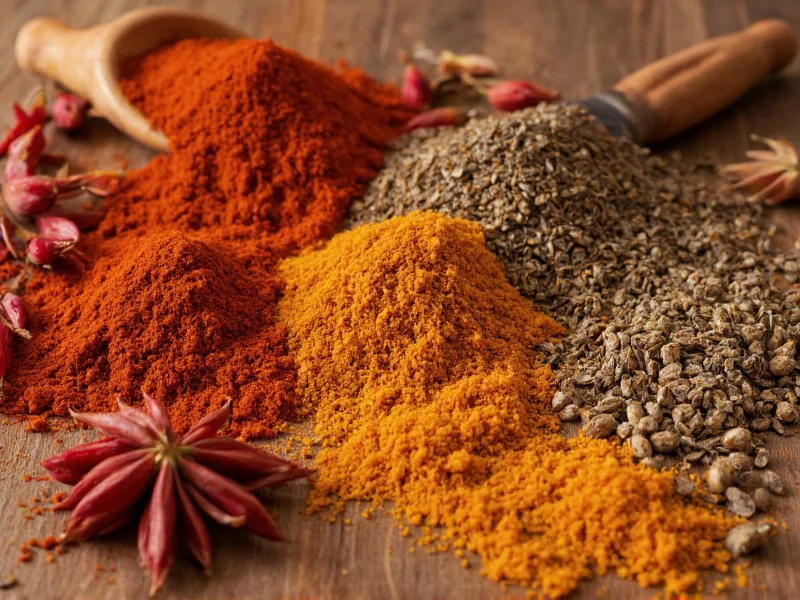Understanding spice shelf life helps maximize flavor in your cooking while reducing kitchen waste. Unlike perishable foods, dried spices and herbs don't spoil in a way that makes them dangerous to consume. Instead, they undergo a slow degradation process where volatile oils evaporate, diminishing their aromatic compounds and flavor intensity.
Decoding Spice Shelf Life Terminology
Many spice containers display "best by" or "use by" dates, but these indicate peak quality rather than safety cutoffs. The actual shelf life depends on multiple factors including:
- Form: Whole spices retain potency longer than ground varieties
- Packaging: Airtight containers significantly extend freshness
- Storage conditions: Heat, light, and moisture accelerate degradation
- Spice type: Robust spices like pepper outlast delicate ones like paprika
Typical Spice Shelf Life by Category
| Spice Type | Whole Form Shelf Life | Ground Form Shelf Life | Key Indicators of Degradation |
|---|---|---|---|
| Peppercorns, Cinnamon Sticks, Cloves | 3-4 years | 2-3 years | Faded color, weak aroma, diminished heat |
| Cumin, Coriander, Cardamom | 3-4 years | 2-3 years | Loss of earthy notes, musty smell |
| Paprika, Chili Powder, Turmeric | N/A | 1-2 years | Color fading (especially reds), flat flavor |
| Dried Herbs (Oregano, Thyme, Rosemary) | N/A | 1-3 years | Brownish color, hay-like smell, brittle texture |
| Spice Blends (Curry, Garam Masala) | N/A | 6-12 months | Imbalanced flavors, dominant single notes |
How to Test Spice Freshness
Don't trust expiration dates—perform these simple freshness tests:
The Visual Inspection
Fresh spices maintain vibrant color. Ground turmeric should be bright yellow-orange, paprika deep red, and cumin rich brown. Faded or dull appearance indicates significant flavor loss. Check for moisture clumps or insect activity, which means immediate discard.
The Aroma Assessment
This is the most reliable freshness indicator. Place a small amount in your palm, rub gently to release oils, then inhale deeply. Fresh spices produce an immediate, potent aroma. If you need to sniff repeatedly to detect any scent, the spice has lost most of its volatile compounds. Properly stored cumin should smell earthy and warm within seconds—not require deep inhalation.
The Taste Test (Use Caution)
For definitive freshness confirmation, taste a tiny amount. Fresh black pepper delivers immediate heat that builds, while stale pepper tastes dusty and one-dimensional. Remember that older spices aren't dangerous—they just lack flavor impact. Never taste spices showing mold or moisture damage.
Optimal Spice Storage Techniques
Maximize your spice investment with these professional storage methods:
Container Selection
Use airtight glass or metal containers with tight-sealing lids. Avoid plastic containers which can absorb odors and allow gradual moisture penetration. Dark glass jars protect light-sensitive spices like paprika. Never store spices in their original paper containers or bags.
Location Matters
Store spices in a cool, dark cupboard away from heat sources. The ideal temperature range is 50-70°F (10-21°C). Avoid locations above stoves, near dishwashers, or in direct sunlight—all accelerate flavor degradation. Humidity control is critical; consider adding silica packets to containers in humid climates.
Organization System
Arrange spices alphabetically or by cuisine type for quick access. Frequently used spices should be most accessible to minimize exposure time. Label containers with purchase dates using a permanent marker on the bottom—this helps track age without visible labels affecting kitchen aesthetics.
When to Replace Your Spices
Replace spices when they fail the aroma test or show visible degradation. As a general guideline:
- Ground spices: Replace after 2 years
- Whole spices: Replace after 3-4 years
- Red spices (paprika, chili): Replace after 1-2 years
- Herb blends: Replace after 6-12 months
Consider your cooking habits—frequent cooks may need to replace spices more often as each opening exposes contents to air and moisture. Professional chefs typically refresh their spice collection every 6-12 months for optimal flavor.
Safety Considerations for Aged Spices
Properly stored dried spices remain safe indefinitely. The primary risk comes from:
- Moisture contamination: Discard immediately if clumping or mold appears
- Cross-contamination: Never return unused spices to original containers
- Pest infestation: Discard entire containers showing insect activity
Unlike oils or nuts, dried spices don't develop rancidity or harmful bacteria when stored properly. The main consequence of using old spices is disappointing culinary results—not health risks.
Maximizing Value from Aging Spices
Before discarding older spices, consider these creative uses:
- Add extra-old spices to marinades where long soaking time compensates for weaker potency
- Use faded spices in strongly flavored dishes like chili or curry
- Create homemade potpourri with aromatic but flavor-weak spices
- Make spice-scented drawer sachets for natural moth repellent
For critical recipes where spice flavor matters, always use fresh spices. Reserve older spices for applications where aroma matters more than precise flavor.











 浙公网安备
33010002000092号
浙公网安备
33010002000092号 浙B2-20120091-4
浙B2-20120091-4